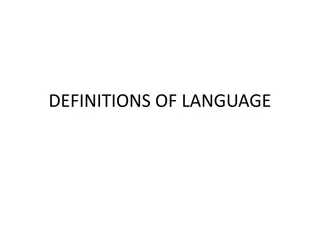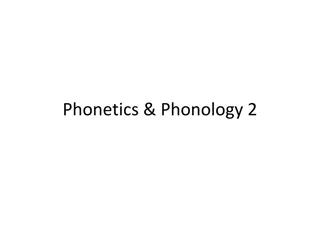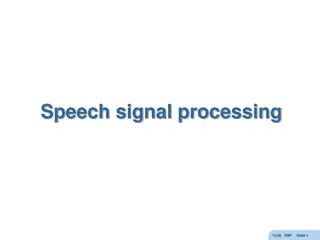Understanding Phonemes and Symbols in English Language
Exploring the concept of phonemes and symbols in English language, this content covers the segmentation of speech sounds, phonemic systems, complementary distribution, and allophones. It delves into the theoretical aspects of speech sounds and how different realizations of phonemes impact the meaning of words.
Download Presentation

Please find below an Image/Link to download the presentation.
The content on the website is provided AS IS for your information and personal use only. It may not be sold, licensed, or shared on other websites without obtaining consent from the author. Download presentation by click this link. If you encounter any issues during the download, it is possible that the publisher has removed the file from their server.
E N D
Presentation Transcript
The phonemes In the previous chapter we have been studying some of the sounds of English. It is now necessary to consider some fundamental theoretical questions. What do we mean when we use the word sound ? How do we establish what are the sounds of English, and how do we decide how many there are of them? When we speak, we produce a continuous stream of sounds. In studying speech we divide this stream into small pieces that we call segments. The word man is pronounced with a first segment m, a second segment ae and a third segment n. It is not always easy to decide on the number of segments. To give a simple example, in the word mine the first segment is m and the last is n, as in the word man discussed above. But should we regard the ai in the middle as one segment or two? We will return to this question.
Phonemes and phonemic system For instance the following examples are all starting with p and ending with t but in each the medial vowel is different, as a result different words with different meaning we get. pat , pet , pit, pot, put . If we look at the short vowels i, e, a , o , u, for example, we can see how substituting one for another in between the plosives p and t gives us five different words as follows (given in spelling bellow): Let us return to the example of letters of the alphabet. phonemes are abstract set of units of speech sounds, and the complete set of these units is called the phonemic system of the language. The phonemes themselves are abstract, but there are many slightly different ways in which we make the sounds that represent these phonemes, just as there are many ways in which we may make a mark on a piece of paper to represent a particular (abstract) letter of the alphabet.
Complementary Complementarydistribution distribution We also find cases in speech similar to the writing example of capital A and little a (one can only occur where the other cannot). For example, we find that the realisation of t in the word tea is aspirated (as are all voiceless plosives when they occur before stressed vowels at the beginning of syllables). In the word eat , the realisation of t is unaspirated (as are all voiceless plosives when they occur at the end of a syllable and are not followed by a vowel). The aspirated and unaspirated realisations are both recognised as t by English speakers despite their differences. But the aspirated realisation will never be found in the place where the unaspirated realisation is appropriate, and vice versa. When we find this strict separation of places where particular realisations can occur, we say that the realisations are in complementary distribution.
Allophones One more technical term needs to be introduced: when we talk about different realisations of phonemes, we sometimes call these realisations allophones. In the last example, we were studying the aspirated and unaspirated allophones of the phoneme t . Usually we do not indicate different allophones when we write symbols to represent sounds. Allophones are different realisations of a phoneme. One of them cannot replace the other one. For instance: /l/ has two allophones in low and well, Aspirated p in peak and unaspirated p in speak are in complementary distribution, which means their positions can never change.
Symbols and transcription You have now seen a number of symbols of several different sorts. Basically the symbols are for one of two purposes: either they are symbols for phonemes (phonemic symbols) or they are phonetic symbols (which is what the symbols were first introduced as). We will look first at phonemic symbols. The most important point to remember is the rather obvious-seeming fact that the number of phonemic symbols must be exactly the same as the number of phonemes we decide exist in the language. It is rather like typing on a keyboard - there is a fixed number of keys that you can press. However, some of our phonemic symbols consist of two characters; for example, we usually treat t (as in chip t ip) as one phoneme, so t is a phonemic symbol consisting of two characters (t and ).
Symbols and transcription One of the traditional exercises in pronunciation teaching by phonetic methods is that of phonemic transcription, where every speech sound must be identified as one of the phonemes and written with the appropriate symbol. There are two different kinds of transcription exercise: in one, transcription from dictation, the student must listen to a person, or a recording, and write down what they hear; in the other, transcription from a written text, the student is given a passage written in orthography and must use phonemic symbols to represent how she or he thinks it would be pronounced by a speaker of a particular accent. In a phonemic transcription, then, only the phonemic symbols may be used; this has the advantage that it is comparatively quick and easy to learn to use it.
The phonemic system described here for the BBC accent contains forty-four phonemes. We can display the complete set of these phonemes by the usual classificatory methods used by most phoneticians; the vowels and diphthongs can be located in the vowel quadrilateral - as was done before- and the consonants can be placed in a chart or table according to place of articulation, manner of articulation and voicing. Human beings can make many more sounds than these, and phoneticians use a much larger set of symbols when they are trying to represent sounds more accurately. The best known set of symbols is that of the International Phonetic Association s alphabet (the letters IPA are used to refer to the Association and also to its alphabet).
Diacritics and centralisation Diacritics are small markings which are placed around the IPA letter in order to show a certain alteration or more specific description in the letter's pronunciation. Diacritics are marks placed above or below (or sometimes next to) a letter in a word to indicate a particular pronunciation in regard to accent, tone, or stress as well as meaning, especially when a homograph exists without the marked letter or letters. For example, p te refers to clay whereas pate refers to the head, and r sum or resum is used for a work history versus resume, which means "to begin again." For example: The dotless i, , is used when the dot would interfere with the diacritic. Other IPA letters may appear as diacritic variants to represent phonetic detail: t (fricative release), t (aspirated), and n (syllabic).
phonetic transcription A phonetic transcription containing a lot of information about the exact quality of the sounds would be called a narrow phonetic transcription, while one which only included a little more information than a phonemic transcription would be called a broad phonetic transcription. One further type of transcription is one which is basically phonemic, but contains additional symbolic information about allophones of particular symbols: this is often called an allophonic transcription. As an example of the use of allophonic transcription, in this course phonetic symbols are used occasionally when it is necessary to give an accurate label to an allophone of some English phoneme, but we do not do any phonetic transcription of continuous speech: that is a rather specialised exercise. A widely-used convention is to enclose symbols within brackets that show whether they are phonemic or phonetic: when symbols are used to represent precise phonetic values, rather than phonemes, they are often enclosed in square brackets [ ], in many phonetics books, phonemic symbols are enclosed within slant brackets / /
Phonology Previously we concerned with matters of phonetics - the comparatively straightforward business of describing the sounds that we use in speaking. When we talk about how phonemes function in language, and the relationships among the different phonemes - when, in other words, we study the abstract side of the sounds of language, we are studying a related but different subject that we call phonology. Only by studying both the phonetics and the phonology of English it is possible to acquire a full understanding of the use of sounds in English speech. Let us look briefly at some areas that come within the subject of phonology; these areas of study will be covered in more detail later in the course.
Study of the phonemic system It is sometimes helpful to think of the phonemic system as being similar to the set of cards used in a card game, or the set of pieces used in a game of chess. In chess, for example, the exact shape and colour of the pieces are not important to the game as long as they can be reliably distinguished. But the number of pieces, the moves they can make and their relationship to all the other pieces are very important; we would say that if any of these were to be changed, the game would no longer be what we call chess. Similarly, playing cards can be printed in many different styles and sizes, but while changing these things does not affect the game played with them, if we were to remove one card from the pack or add one card to it before the start of a game, nobody would accept that we were playing the game correctly. In a similar way, we have a more or less fixed set of pieces (phonemes) with which to play the game of speaking English. There may be many slightly different realisations of the various phonemes, but the most important thing for commuseunication is that we should be able to make use of the full set of phone.
Game Use the following to make English words: ( e, a, s, I, t ) seal, least, test, last, salt, steel, late, east, else, seat. Use the following to make English words: (m, n, e, a, s ) Me, as, man, men, mean, mama, name, sea, seen, sane.
Phoneme sequences and syllable structure In every language we find that there are restrictions on the sequences of phonemes that are used. For example, no English word begins with the consonant sequence *zbf and no word ends with the sequence *aeh. In phonology we try to analyse what the restrictions and regularities are in a particular language, and it is usually found helpful to do this by studying the syllables of the language. syllable: a unit of pronunciation having one vowel sound, with or without surrounding consonants, forming the whole or a part of a word; for example, there are two syllables in water and decide. and three in informal and uniform.
Suprasegmental phonology Many significant sound contrasts are not the result of differences between phonemes. For example, stress is important: when the word import is pronounced with the first syllable sounding stronger than the second, English speakers hear it as a noun, whereas when the second syllable is stronger the word is heard as a verb. Import noun Im port verb Intonation is also important: if the word right is said with the pitch of the voice rising, it is likely to be heard as a question or as an invitation to a speaker to continue, while falling pitch is more likely to be heard as confirmation or agreement. Right question Right agreement These examples show sound contrasts that extend over several segments (phonemes), and such contrasts are called suprasegmental.























